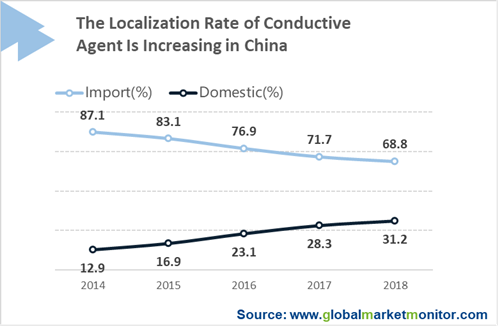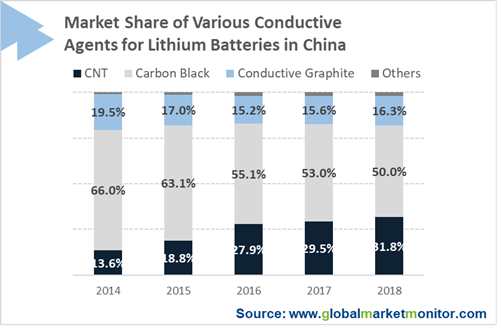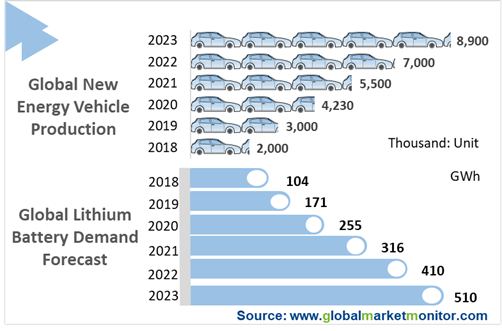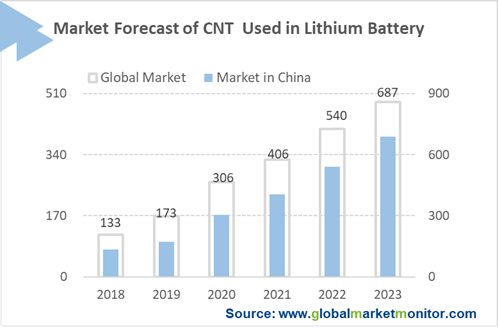Lithium batteries are a type of chemical batteries that rely on lithium ions to shuttle between positive and negative electrodes to achieve the purpose of charging and discharging. Due to their advantages of high energy density, high operating voltage, and long life, they have been widely used New energy vehicles, computers, and energy storage batteries.
The main materials of lithium batteries include cathode materials, anode materials, and electrolytes, and separators, and conductive agents. As a key auxiliary material, the conductive agent can increase the conductive contact between the active materials to increase the transmission rate of electrons in the electrode in the lithium battery, thereby improving the rate performance of the lithium battery.
CNT Conductive Agent VS Traditional Conductive Agent
Traditional conductive agents mainly include carbon black and conductive graphite, both of which mainly rely on imports. Carbon black conductive agent is divided into SP conductive agent, Ketjen black conductive agent, and acetylene black conductive agent, where the SP conductive agent has a lower price but the conductive performance is relatively poor with the large added amount. The Ketjen black conductive agent added in a small amount is suitable for high-rate, high-capacity lithium batteries, of which the price is high and it is tough to be dispersed. Acetylene black has good liquid absorption, but it easily affects the compaction performance of the pole piece.
CNT has the feature of high conductivity and aspect ratio, which contributes to form a conductive tube network structure. The impedance of carbon nanotubes with the amount added between one-sixth and half of traditional conductive agents is half that of the traditional agents. And its gross profit is almost equivalent to the separator, higher than the positive electrode, negative electrode, and electrolyte.
Get Your Custom Report Immediately:
https://globalmarketmonitor.com.cn/request.php?type=3&rid=202585
Although the current price of CNT per unit lithium battery is 1.8 to 3.5 times that of SP, we believe that its price will be attributed to the industry's normal price with the continuous update of carbon nanotube technology and the continuous expansion of scale. At that time, under the same conditions, CNT agents with higher performance are more and more popular.
The Penetration Rate of CNT Agents Is Improving, Which Is Expected to Change the Dependence of Domestic Traditional Conductive Agents on Imports.
Before the emergence of new conductive agents such as carbon nanotubes, the mainstream traditional conductive agents on the market include SP, acetylene black, and KS, and VGCF, mainly from Cabot of the United States and TIMCAL of Switzerland, and Japan Lion and so on, all of which have controlled the market of traditional conductive agents, so lithium battery companies in China have been dependent on imports for lithium battery conductive agents for a long time. However, the domestic improvement of CNT technology and the deepening of its recognition, more than 80% of the global capacity of CNT conductive agent for lithium battery comes from China, and the market share of carbon nanotubes is increasing year by year. At the same time, we have noticed that the localization rate of domestic conductive agents is also steadily increasing, from 12.9% in 2014 to 31.2 in 2018. CNT not only become the leader of new conductive agents for lithium batteries, but also serve as a pioneer in changing the dependence of domestic traditional conductive agents on imports.


The Development of New Energy Vehicles Drives the Demand for Lithium Batteries
As a new material, CNT is currently mainly used as a new conductive agent in the field of lithium batteries. The lithium battery industry is booming with the rapid increase of new energy vehicles worldwide.

In the global market, the output value of CNT conductive paste for lithium batteries in 2018 increased by 21.2% year-on-year to 133 million USD. It is estimated that by 2023, the output value of the global CNT conductive paste market for lithium batteries will exceed 687 million USD, with a compound annual growth rate of 40.3% in the next five years.

In the domestic market, the production capacity of the CNT conductive paste market for lithium batteries in China increased by 19.1% in 2018, reaching 121 million USD. It is expected that by 2023, the output value of the CNT conductive paste market for power lithium batteries in China will exceed 4.9 million USD. In the next five years, the compound average growth rate will reach 32.0%.
LEARN MORE:
CNT
https://www.globalmarketmonitor.com/reports/532254-carbon-nanotubes--cnt--market-report.html
Custom Reporting
https://www.globalmarketmonitor.com/request.php?type=9&rid=0
We provide more professional and intelligent market reports to complement your business decisions.